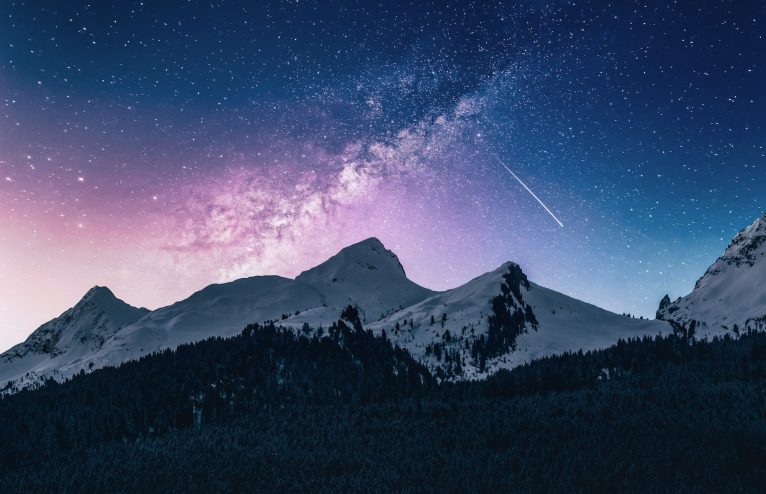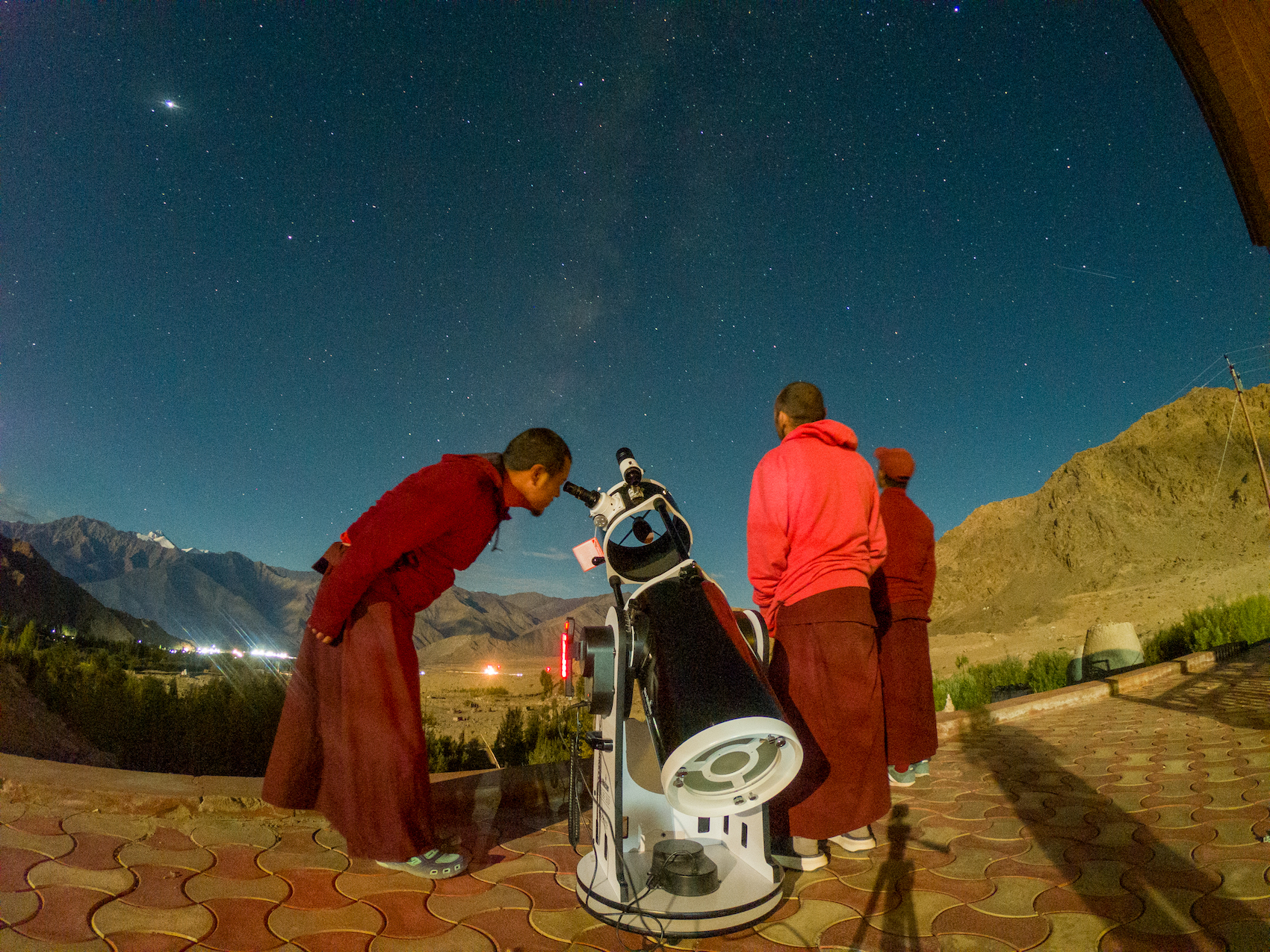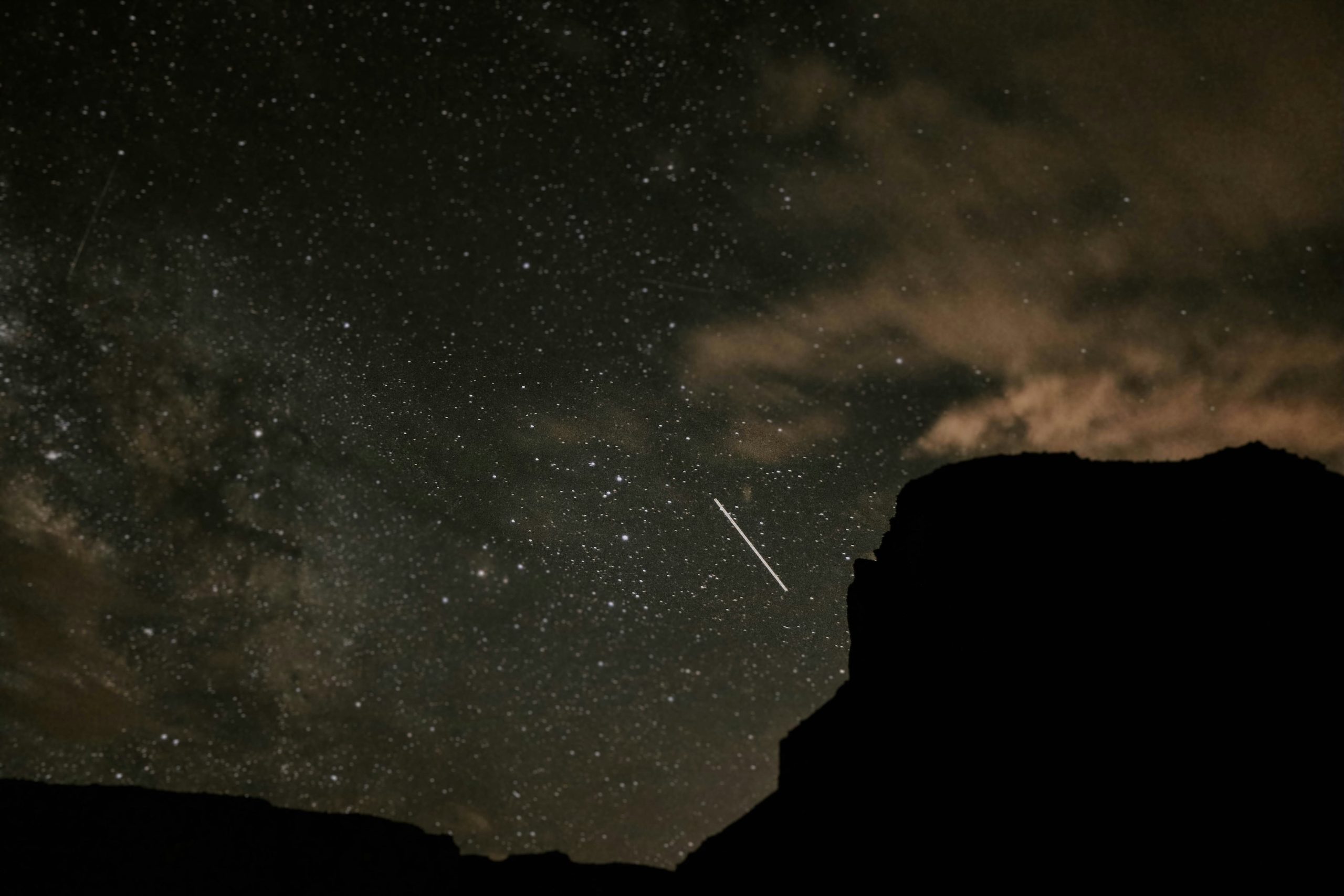Astrotourism is one of our 2024 travel trend predictions. Here, Megan Eaves explains how dark sky tourism and starry night skies are transforming travel, alongside revealing some of the best places in the world to go and see them.
It is a frosty night and I am standing on a Yorkshire hillside wrapped in layers, staring up at a patch of stars twinkling in between winter clouds. A blanket of snow covers the ground and, around me, families and couples are taking turns looking through a telescope while astronomer Richard Darn points out two bright objects in the sky: Jupiter and Saturn are putting on a winter show. I’m taking part in an evening of dark skies in North York Moors National Park in northern England – a package offered by The Grand Hotel in York.
You might not expect a five-star luxury hotel in a city to be the place for stargazing, but The Grand’s offering is special: dinner and a tour of the night sky in the North York Moors Dark Sky Reserve. Luxe transport is included to and from the Sutton Bank Star Hub, only 45 minutes from the hotel’s door, where the stargazing takes place inside the reserve, away from York’s urban light pollution.
Dark Sky Tourism Is A Growing Tourism Trend. Here’s Why:
Going in search of a natural, starry sky and a dark night’s sleep is a growing tourism trend. Staggering statistics indicate the loss of the natural night around the world – light pollution is increasing at 10 per cent per year globally, with 99 per cent of people in Europe and North America no longer able to see the stars from their homes.
As light pollution affects our health and disturbs our sleep, many city dwellers are seeking the rest and recuperation provided by switching off and sleeping in natural darkness. And, as more people look to connect with nature in the aftermath of lockdowns, it makes sense that travellers want experiences that provide a sense of awe and connection to the cosmos.
Made from 16 light frames by Starry Landscape Stacker 1.8.0. Algorithm: Min Horizon Star Dupe
Dark sky travel provides a connection to nature through astrotourism (stargazing, moongazing, aurora-spotting and astronomy science) and other nighttime activities, such as night hikes, nocturnal wildlife watching, nighttime mindfulness and wellness experiences, sleep tourism, and arts activities like concerts under the stars. These experiences can also incorporate related cultural themes, like the zodiac (astrology), myths and legends connected to the night sky.
According to Simon Mahon, The Grand Hotel’s general manager, their dark sky package is especially popular with visitors from bigger cities and light-polluted areas. Since dark sky experiences necessitate visiting remote places away from urban light pollution, driving is often necessary – The Grand is addressing this challenge by providing transport to and from the stargazing area.
“You can get the train up from London, Manchester, Liverpool or from abroad and we drive you out to see the stars. It’s really popular,” says Mahon, adding that all of The Grand’s eight dark sky evening packages sold out in 2023.
What Exactly Is Dark Sky Tourism?
International Dark Sky Reserves like the one at North York Moors are among the certifications granted by DarkSky International (formerly the International Dark-Sky Association), a global non-profit organisation focused on reducing light pollution and restoring the natural night around the world. In preserving the starry skies and the naturally dark nights that people, creatures and plants need to survive, these International Dark Sky Places are also opening up new tourism opportunities and protecting nature and communities at the same time.
Obtaining International Dark Sky Place certification is similar to UNESCO World Heritage status – preserves must go through a rigorous application process that ensures lighting in the area is limited and meets a non-pollutive standard, and that the local community is active and supportive.
The Grand Hotel’s astronomy guide, Richard Darn, has been involved in helping several parks and reserves in the UK gain International Dark Sky status, including North York Moors National Park, in 2020. He tells us that certification helps “put them on the map” for dark sky tourism, continuing to explain that “it gives you a profile, and you can use that profile. You can use it to drive astrotourism. It can give your tourism businesses some shoulder-season activity. It can get hotels like The Grand to work more closely with the national parks. Without the dark sky designation, you’ve got no leverage.”
In 2023, DarkSky International announced a new certification scheme for accommodation: DarkSky Approved Lodging, intended to complement International Dark Sky Places by certifying lodges, inns, resorts and camps that provide opportunities for visitors to spend the night in a dark location. According to Ruskin Hartley, CEO of DarkSky International, properties must meet a set of standards to become certified, including being “located in a region with exceptional dark skies, reducing the impact of light at night through responsible lighting design, and providing programmes and activities on nocturnal conservation to guests.”
Under Canvas Lake Powell. Image credit: Travis Burke
US glamping brand Under Canvas created the first – and so far only – DarkSky Approved Lodging pilot location at their property in Lake Powell, Utah. It features non-pollutive lighting with an unobtrusive, warm colour tone and no upward light spill, preserving the sparkling Milky Way above, as well as the dark, desert ecosystem for wildlife surrounding the camp. DarkSky has just opened the programme for applications and will begin certifying more properties this year. The expectation is that they will see a range of accommodations certified, from high-end resorts in eco-tourism areas to jungle lodges.
Where Are The Best Places to See The Night Sky?
C:DCIM100GOPROGOPR2693.GPR
There are 210 (and counting) certified International Dark Sky Places all over the world, ranging from North York Moors National Park, where The Grand’s stargazing excursions take place, to spots across Europe, Asia and Latin America. To find a park or reserve near you, or in your travel destination, check out DarkSky’s website, which has them listed by geography. These places often boast a range of tourist offerings, such as Wild Intrigue, which offers unique experiences like ‘dawn chorus discos’ and ‘bat-and-pizza nights’ in Northumberland Dark Sky Park. You might find yourself sleeping in a geodesic dome at Elqui Domos in Chile’s Elqui Valley, an International Dark Sky Sanctuary. Or experiencing the starry highs of the Himalaya at a women-run astro-homestay in Ladakh, India.
How Do Dark Sky Experiences Differ?
Much of the awe and perspective that we gain from spending time under a starry sky comes from its unchanging nature. We can look up and know that a loved one far away also sees the same Moon and stars and that people throughout history have gazed at the same sky for inspiration, guidance and comfort. But if the night sky is essentially the same almost everywhere, why travel to see it?
As dark sky tourism has grown in popularity over the past few years, so have the destinations and variety of experiences on offer. The most successful of these incorporate an introduction to the night sky – something that, without human-made light pollution, would be visible from anywhere on Earth – with local culture, such as star lore, myths, food and drink, arts and unique aspects of the landscape.
Night skies in Utah, USA
This makes my experience of viewing Jupiter on a snowy night in north Yorkshire completely different to watching Jupiter rise over the strange, red rock formations in the Utah desert – which I did a few weeks prior – or seeing it shining brightly overhead surrounded by the mountain peaks of Taiwan several years ago. For starters, the positions of the stars and planets change depending on where you’re standing on the planet. At more northern latitudes, the planets and stars appear farther down along the southern aspect of the sky, whereas at the equator, they are directly overhead. Local weather and climate also play a role: the wintery Yorkshire night sky took on an ethereal quality with stars shining brightly through passing snow clouds. Here, the land, trees, rocks and hills wrap around you like an old, warm blanket. But in Utah, the wide landscapes allow you to see for miles and miles, and the sky seems to go on forever. You feel like a tiny speck swimming in a huge bowl of sky.
Beyond the physical landscapes, there are the cultural and historical contexts that add an extra dimension to the enjoyment of the night sky. During my experience in Taiwan, we spent a few minutes consulting a Mandarin-language paper star map and learning the local versions of constellations before going outside to see them. In mainland China, I’ve spent several Mid-Autumn Festivals gazing at the brightest Moon of the year, my surroundings illuminated gently by traditional paper lanterns. There, I couldn’t help but think of the Chinese myth of the goddess Chang’e, who accidentally took an elixir of immortality and fled to the Moon to pine for her love, the mortal warrior Hou Yi, for eternity. These cultural stories and star lores become central to experiencing the night sky in different places.
Richard Darn agrees that the surrounding landscapes and cultures, including the weather, landmarks, arts, cultural heritage and climate, all play a part in creating a different experience of the night in every location. This sentiment is also echoed by Mohammad Saleh Timar, a stargazing guide from Iran who tells me that his nighttime tours of the desert not only connect travellers with the vast Iranian landscapes but also help to restore lost caravanserai and ruined villages, imparting a sense of the local ecology and Silk Road history together with the stars.
Four Seasons Wailea
In Hawaii, the Four Seasons Resort Maui showcases the oceanscape and Indigenous Polynesian heritage on the Wayfinder’s Journey, a nighttime sailing adventure led by master female navigator, Kala Baybayan Tanaka. According to Margaux Pfeiffer, Director of Concierge and Guest Experience at the resort, the experience “brings guests on a journey back in time to the origins of Hawai’i, uncovering the stories of Kala’s Polynesian ancestors, who navigated the open ocean using only the stars, swells and other natural elements in a voyaging canoe.”
How Dark Sky Tourism Is Supporting Communities And Sustainability In Travel
Travel has in many ways become a pursuit of meaningful experiences, and travellers increasingly value environmental sustainability, slowing down and spending quality time in fewer places.
Dark sky tourism has already proved to be attractive to travellers and lucrative for local communities. Galloway Forest Park, the first International Dark Sky Park in the UK, generated an estimated £500,000 a year from dark sky tourism in its first decade after certification. Northumberland Dark Sky Park saw similar benefits, including a 15 per cent increase in business performance and support for 450 local jobs. Antofagasta in Chile’s Atacama Desert – one of the world’s premier astrotourism destinations – has seen 327 per cent year-on-year growth through dark sky tourism, while other starry-sky destinations have seen similar results.
Stargazing in the Atacama Desert, Chile
One successful, community-led dark sky venture is Astrostays in Ladakh, India. It has equipped women homestay owners in high, remote Himalayan communities with telescopes and astronomy training so that they can offer stargazing in the clear, mountain nights, along with their crafts and products for sale. In 2023, the venture added a new ‘Cosmohub’ night sky centre with a traditional dinner experience and stargazing with monks at a 700-year-old Buddhist monastery.
Ventures like these are connecting travellers back to the nighttime environment and at the same time creating new livelihoods for developing and rural communities requiring relatively little up-front investment and infrastructure. Samyukta Manikumar, an astrotourism expert and co-founder of DarkSky Kenya, says there is potential for dark sky tourism to make a difference to local people in places like Kenya, where there are many unelectrified areas and an abundance of existing wildlife conservancies.
“Nature conservation and wildlife tourism go hand in hand in Kenya, and I hope to see something similar happening with dark sky tourism and nocturnal conservation,” she says. “It has the potential to create employment opportunities in the tourism industry that could help address the youth unemployment problem that’s spread across the country and continent.”
View of the Milky Way from Tsavo West National Park, Kenya
Dark sky tourism requires overnight stays and eases peak season strain by encouraging visits during low and shoulder seasons to take advantage of winter’s longer nights. It also cuts down overtourism by spreading visitors out to rural locations and smaller communities. In many ways, protected darkness is a form of natural capital for rural and low-income communities, which they can utilise with very little investment or startup needs.
In addition to building the traveller’s sense of awe and connection to nature and reducing stress, dark sky tourism builds local community networks and brings businesses together in new ways. Richard Darn says this has resulted in what he calls ‘micro-businesses’ opening or expanding their offerings to include a dark sky element, as well as new festivals cropping up that attract travellers in the very low season when many local communities are most in need of income.
Starry Innovations
In November 2023, I attended a conference in Ethiopia held by the International Astronomical Union on the topic of dark sky tourism in developing economies. The experiences presented were as diverse as the many cultures and nations: star bathing on salt pans in Botswana, night trekking in Nepal, sky viewing from an ancient Silk Road observatory in Iran, or a walking tour of historical sites from the 1882 transit of Venus in Guadalajara, Mexico. My bucket list grew exponentially with each idea presented.
The massive ecotourism development at The Red Sea in Saudi Arabia is planning ahead to protect its dark nights for travellers. The project did an extensive nighttime assessment of existing darkness conditions and light pollution, and the luxury resorts opening there, such as the Six Senses Southern Dunes, must adhere to a strict lighting management plan to protect the nocturnal environment and prevent any increase in artificial light at night. Many will also offer desert stargazing experiences that introduce Arabian astronomical heritage. The Red Sea’s aspiration is to create the world’s largest International Dark Sky Reserve.
In Arizona, not far from where DarkSky International is headquartered, a new International Dark Sky Discovery Center is under construction, which will exhibit how important dark skies are to the wellbeing of humans, plants and animals, and will incorporate an astronomical observatory, planetarium, interactive displays and hands-on learning. According to Vicky Derksen, one of the centre’s board members and host of the Night Sky Tourist podcast, “when over 80 per cent of people on Earth can no longer see the Milky Way from where they live, they suddenly realise there are great places to go to have a magical experience under the stars.” She says the new centre will make people “fall in love with the night sky and then break their hearts by introducing them to the impact light pollution has.”
The Future Is Dark, Not Bright
Dark sky travel is still a very new form of tourism developing naturally out of grassroots efforts to conserve and restore the nocturnal environment. Like any successful ecotourism, dark sky experiences must include thoughtful education. Just as a value for wildlife can’t be instilled through elephant-riding experiences or dolphin shows, people can’t gain an appreciation for the natural night without understanding what we are losing as it disappears and how light pollution negatively affects our health and world.
As Vicky Derksen puts it, “Once people learn what can be done to protect our dark skies and discover places around the world that are actively working to bring back the starry nights, they’ll want to visit these places. They’ll want to see what they’ve missed their whole lives if they’ve lived in or near big cities. I expect that more and more resorts in darker locations will lure guests with night sky experiences.”
At the end of our evening in the North York Moors, Richard Darn leads us into a heated room lit only by soft, red bulbs – red-wavelength light is easier on most creatures’ eyes, including humans, and has fewer negative impacts on the natural environment than the bright blue/white light emitted by LEDs and phones. He switches on a projector with information about the disappearing night. It explains how each of us can do our part to help restore Earth’s nocturnal ecosystems by checking the lighting at our homes, closing curtains, using shields, timers and motion sensors, and turning off lights that aren’t needed.
Bedroom at The Grand, York
I overhear the guests behind me saying they should check their back garden lights, and a young girl at the front raises her hand and asks Richard what is in the middle of a black hole. He chuckles and says no one knows and maybe she should study astronomy and solve the mystery. For me, it is a hopeful moment. We humans have always been filled with wonder about the night sky, which makes us want to explore and protect it. But that can only happen as long as the next generation can still see the stars.
We may earn a commission if you buy something from any affiliate links on our site.






























Any Questions or Tips to add?